How to Cook Turkey Wings
How to Cook Turkey Wings: A Complete Guide for Tender, Flavorful Results

Turkey wings don’t often get the spotlight—but as a chef, I can tell you they absolutely deserve it. Rich in flavor, budget-friendly, and incredibly versatile, turkey wings are one of my favorite poultry cuts to work with. They offer a deep, almost gamey taste that feels more complex than chicken, while still being mild enough to take on bold marinades, sauces, and spice rubs.
- Why Turkey Wings Are a Hidden Gem
- Understanding Turkey Wing Anatomy and Cooking Behavior
- How to Select High-Quality Turkey Wings
- Preparing Turkey Wings for Cooking
- Essential Ingredients for Perfect Turkey Wings
- Oven-Roasted Turkey Wings for Beginners
- Cooking Times and Internal Temperature Chart
- Skillet-Cooked Turkey Wings: My Browning and Braising Technique
- Tender Turkey Wings in the Pressure Cooker
- How to Cook Turkey Wings in the Microwave (Yes, Really)
- Common Mistakes When Cooking Turkey Wings
- Chef-Recommended Sauces and Gravies for Turkey Wings
- Seasoning Blends That Work Best for Turkey Wings
- Popular Variations and Recipe Ideas
- Storing and Reheating Turkey Wings the Right Way
- What to Serve with Turkey Wings and How to Plate Them
- FAQ: 15 Questions About Cooking Turkey Wings — Answered by a Chef
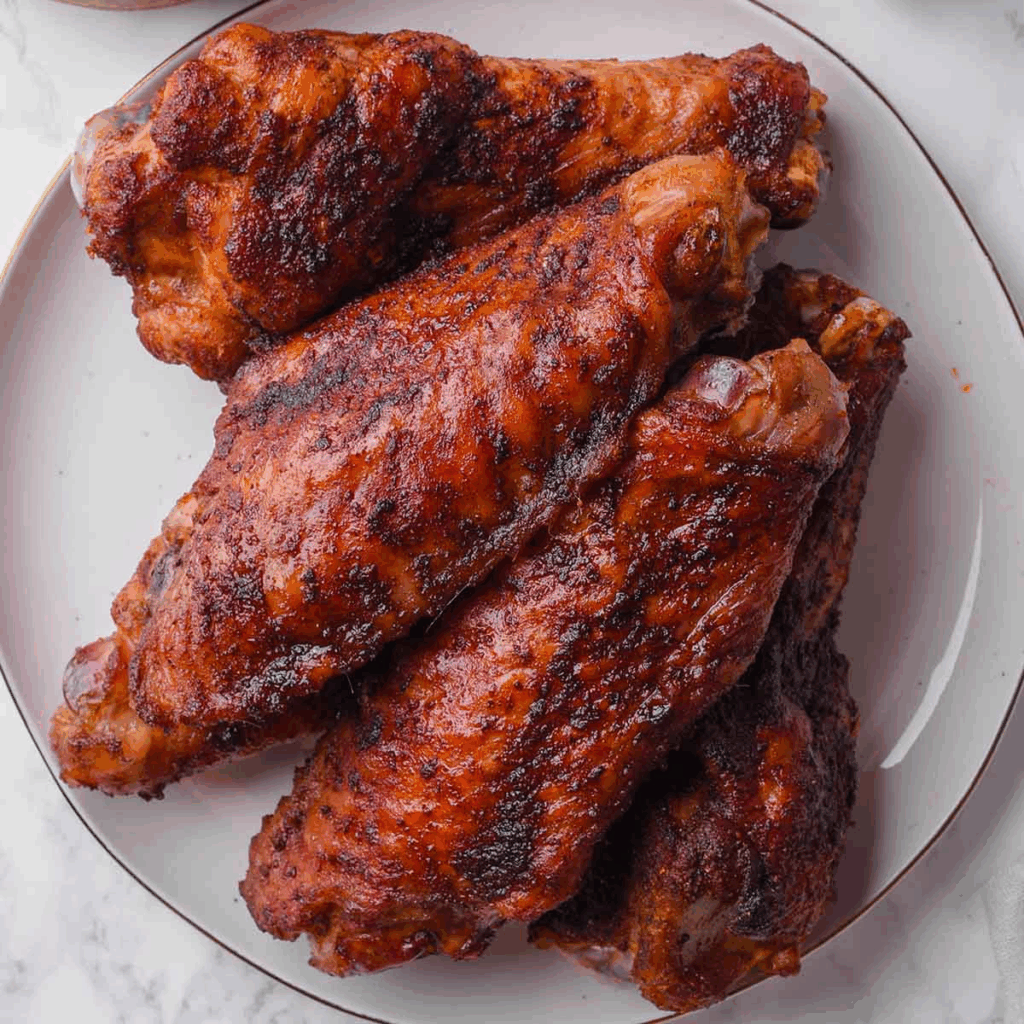
Why Turkey Wings Are a Hidden Gem
What I love most is how adaptable they are. Whether I’m roasting them crispy in the oven, braising them low and slow, or flash-searing them in a skillet, turkey wings respond beautifully to technique. They’re perfect for hearty meals, small gatherings, or even leftovers you can shred into tacos or stews.
Compared to turkey breasts, which dry out easily, wings contain more fat and connective tissue, meaning they stay moist when cooked correctly. That fat is also what helps develop a rich flavor base for sauces and gravies. If you haven’t cooked turkey wings before, this guide will walk you through everything—from prep to plating—with chef-tested methods that anyone can master.
Understanding Turkey Wing Anatomy and Cooking Behavior
To cook turkey wings well, it helps to know what you’re working with. Each wing is made up of three parts: the drumette, the flat (or mid-section), and the wing tip. These vary not only in size but in muscle density and fat content, which affects how they cook.
The drumette is the meatiest section, shaped like a small drumstick. It contains dense muscle and a good amount of fat. I usually give it a bit more time in the oven or skillet, as it takes longer to soften and absorb flavors. It’s also where I check internal temperature.
The flat has two bones and slightly less meat, but more collagen and connective tissue. This section becomes luxuriously tender when braised and is ideal for soaking up sauces and spices. I handle it gently in the skillet to keep it intact.
The tip, while mostly bone and skin, is full of collagen and fat. I rarely discard it—I use it in the pan to boost flavor or save it for stock. If you’re roasting whole wings, leave the tip attached to help baste the meat naturally.
Understanding these parts lets you control the cook: more time and seasoning for the drumette, careful handling of the flat, and smart use of the tip for added richness.
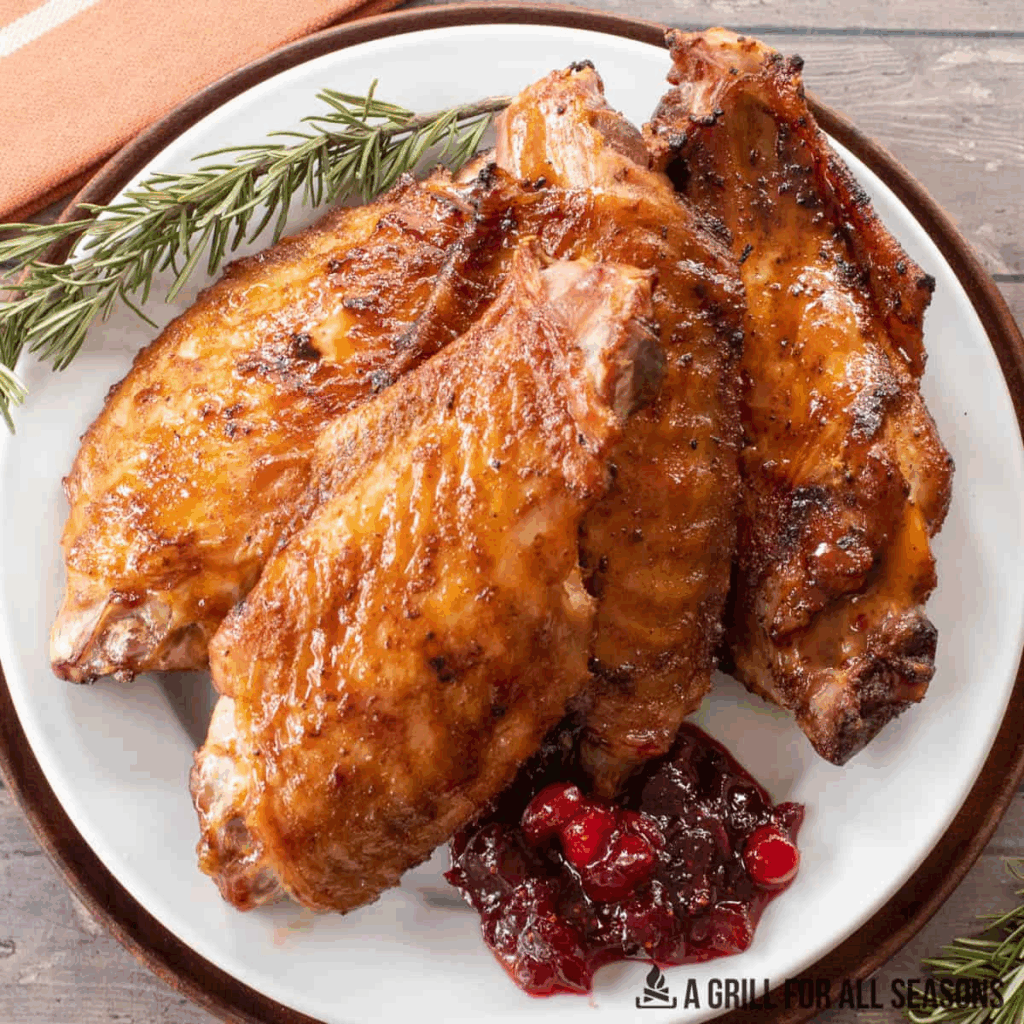
How to Select High-Quality Turkey Wings
In my kitchen, the cooking process always starts at the butcher counter. Selecting good-quality turkey wings makes every other step easier and tastier. Whether I’m shopping at a local farm or a grocery store, I follow the same rules every time.
If available, I go for fresh turkey wings—they tend to have better skin elasticity, more vivid pink meat, and no freezer burn. Frozen wings are fine too, but I check that the packaging is sealed and free of ice crystals, which can indicate improper storage or thawing and refreezing.
The ideal size for turkey wings is around 8 to 12 ounces per wing. Larger wings work best for braising and roasting, while smaller ones crisp up better in a skillet or air fryer. I also inspect for even skin coverage and no dark spots or broken bones. Freshness shows through smell too—there should be no sour or overly strong poultry odor.
Lastly, I avoid overly pre-trimmed wings. I want the tips included, and I prefer to remove excess skin or fat myself. It gives me more control over flavor and presentation. Buying smart sets the stage for better seasoning, better browning, and better texture later on.
Preparing Turkey Wings for Cooking
Before applying heat, I give my turkey wings the attention they deserve. Good prep not only enhances flavor, it ensures even cooking and crisp skin—especially when roasting or pan-searing.
First, I rinse the wings under cold water, then pat them completely dry with paper towels. Any leftover moisture will steam instead of sear, ruining the texture. Once dry, I trim off excess flaps of skin or fat—but I leave the skin fully intact on the drumette and flat to protect the meat during cooking.
I often score the thickest part of the drumette with a shallow knife cut, which helps marinades or dry rubs penetrate deeper. If I’m roasting, I may apply a dry rub with salt, paprika, garlic powder, and herbs, letting it rest for 1–2 hours in the fridge. This helps dry the skin further and intensifies the flavor.
When I have time, I use a buttermilk or citrus-based marinade to tenderize the wings, especially for air frying or high-heat roasting. Acidic marinades work best when balanced with oil and aromatics—lemon, vinegar, olive oil, and thyme is a favorite combination in my kitchen.
Whether dry or wet seasoned, I always let the wings sit at room temperature for 20–30 minutes before cooking. This reduces temperature shock and promotes more even doneness from bone to skin.
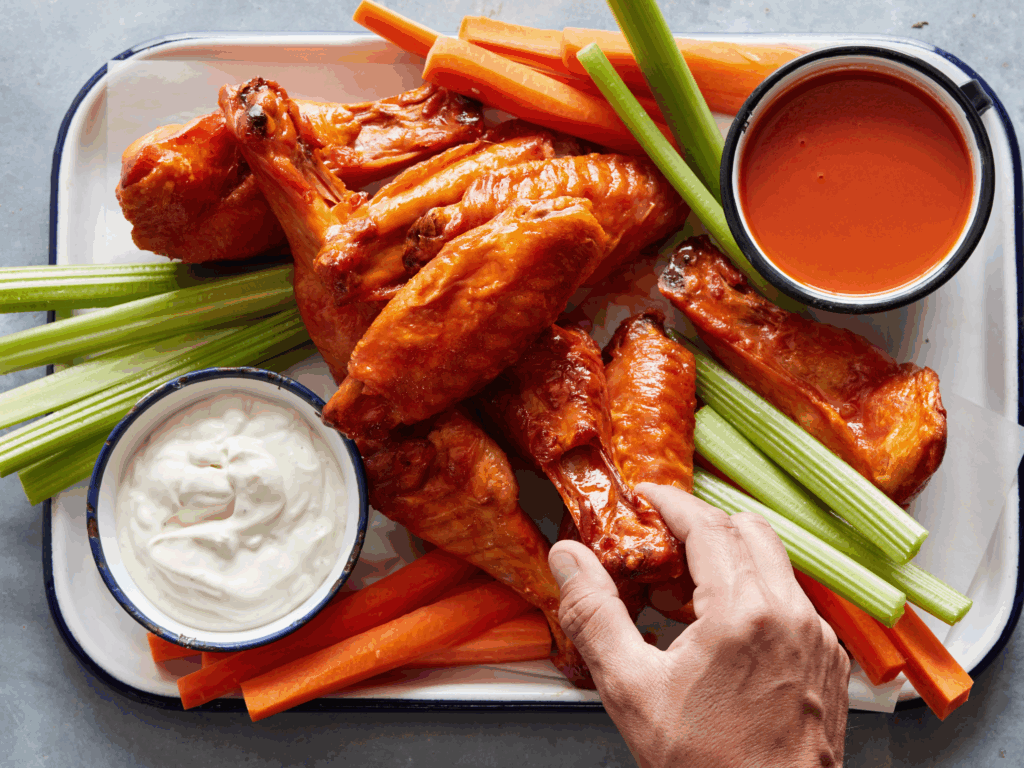
Essential Ingredients for Perfect Turkey Wings
Here are the foundational ingredients I rely on when cooking turkey wings in any method—roasting, skillet, pressure cooker, or microwave:
- 2½–3 lbs turkey wings (whole or separated)
- 2 tablespoons olive oil or melted butter
- 1½ teaspoons kosher salt
- 1 teaspoon black pepper
- 1 teaspoon smoked paprika
- ½ teaspoon garlic powder
- ½ teaspoon onion powder
- Optional: ½ teaspoon cayenne (for heat)
- Fresh thyme, rosemary, or sage (whole sprigs or chopped)
- ½ cup broth (for pressure cooking or braising)
- 1 tablespoon vinegar, lemon juice, or mustard (for marinade)
From this base, I can pivot into nearly any flavor profile: sweet, savory, herby, or spicy. The key is balance—fat for moisture, acid for depth, and salt to make it all pop.
Oven-Roasted Turkey Wings for Beginners
Roasting is the first method I teach home cooks when it comes to turkey wings. The oven gives you complete control over temperature and texture, and the results—when done right—are both crispy and juicy.
I always start by preheating the oven to 375°F (190°C). While that’s happening, I place the seasoned turkey wings on a wire rack set over a foil-lined baking tray. The rack allows hot air to circulate fully and helps render the fat without steaming the skin. If you don’t have a rack, I prop the wings on top of sliced onions or root vegetables to achieve a similar lift.
During the first half of cooking, I cover the tray loosely with foil, especially for large or thick wings. This traps moisture and starts breaking down the connective tissue. After about 45 minutes, I remove the foil to allow the skin to crisp up. I baste the wings once or twice with their own rendered fat or a little melted butter to deepen the color and flavor.
For extra color and caramelization, I often raise the temperature to 425°F (220°C) in the final 10 minutes. Once the wings reach 175°F (80°C) at the thickest point, I remove them from the oven and let them rest for 10–15 minutes. This pause is crucial—it keeps the juices inside and ensures the wings stay tender after cutting.

Cooking Times and Internal Temperature Chart
Accurate internal temperature is more important than total cooking time when it comes to turkey wings. I never rely solely on minutes—I rely on a good thermometer and visual cues developed through repetition.
Here’s the internal temperature chart I use in my kitchen:
| Method | Heat/Power Setting | Target Temp | Time Range | Chef’s Notes |
| Oven (roasting) | 375°F / 190°C | 175–180°F / 80–82°C | 60–75 min | Covered early, uncovered later for crisp skin |
| Skillet (sear + cover) | Medium–low heat | 175°F / 80°C | 30–40 min | Sear both sides, then steam with lid |
| Pressure cooker | High pressure | 180°F / 82°C | 30–35 min | Use ½ cup broth, natural release |
| Microwave | 1000W power | 175°F / 80°C | 10–14 min per lb | Rotate halfway, rest under cover |
I insert my thermometer into the thickest part of the drumette, avoiding the bone. Once I hit target temp, I remove the wings and let them rest. I’ve tested these numbers countless times, and they consistently produce tender, juicy meat with no guesswork.
Skillet-Cooked Turkey Wings: My Browning and Braising Technique
Cooking turkey wings in a skillet is my go-to when I want rich browning and pan sauce, without turning on the oven. It’s a great option for small batches or days when you’re short on time but still want depth of flavor.
I heat a heavy skillet—usually cast iron—over medium heat with a splash of neutral oil. Once hot, I add the wings skin-side down and let them brown undisturbed for 6–8 minutes. When the skin is golden and crisp, I flip and sear the other side for another 5 minutes.
At this point, I reduce the heat to low, pour in about ¼ cup of broth or white wine, and immediately cover the pan. The trapped steam tenderizes the interior while preserving the browning. I let the wings cook like this for 20–25 minutes, occasionally flipping to ensure even cooking.
Once they’re fully cooked and tender, I remove the lid, let the remaining liquid reduce, and stir in a pat of butter or a splash of mustard. The resulting glaze is complex and savory—like a built-in pan sauce that clings perfectly to the skin.
Tender Turkey Wings in the Pressure Cooker
The pressure cooker is unbeatable for getting fall-apart turkey wings in under an hour. I often use this method when I plan to shred the meat for tacos, rice bowls, or soup—it’s fast, flavorful, and virtually foolproof.
I begin by browning the wings in the pot on sauté mode if using an electric model, or in a separate skillet for stovetop versions. This step develops flavor and helps keep the skin from going rubbery. Once seared, I deglaze the pot with a splash of vinegar or wine, then add ½ cup of broth, plus herbs or aromatics like onion, thyme, and garlic.
I cook at high pressure for 30–35 minutes, then let the pot release pressure naturally. Quick release can pull moisture from the meat and sometimes toughen the texture. Once the lid is off, I carefully remove the wings—they’re usually so tender they’ll break apart under their own weight.
If I want crisper skin, I transfer the wings to a baking sheet and broil them for 5 minutes. Otherwise, I serve them straight from the pot with a ladle of the reduced cooking liquid as a rustic sauce. This method is a lifesaver on busy days, and the result is always comforting and satisfying.
How to Cook Turkey Wings in the Microwave (Yes, Really)
While I don’t use the microwave for turkey wings every day, it’s a method I turn to when I need a quick meal or want to reheat without drying out. With the right setup, you can cook tender wings that are surprisingly good—especially with smaller cuts.
I use a deep, microwave-safe covered dish—like a glass casserole with a lid or a silicone steamer tray. I place the wings inside, skin-side up, with about ½ cup of broth or citrus marinade. Then I cover loosely (never airtight) to allow steam to escape.
I microwave at high power (1000W) for about 12–14 minutes per pound, rotating or flipping the wings halfway. If they’re stacked, I rearrange them gently to ensure even cooking. I always check the temperature at the thickest point of the drumette—once it hits 175°F, I let the wings rest for 5 minutes under the cover to finish cooking in their own steam.
The result is moist meat with a steamed texture, ideal for pulling apart or mixing into a dish. If I want a crisper finish, I transfer the wings to a hot skillet or broiler for 2–3 minutes. It’s not a gourmet method, but in terms of practicality, it gets the job done.
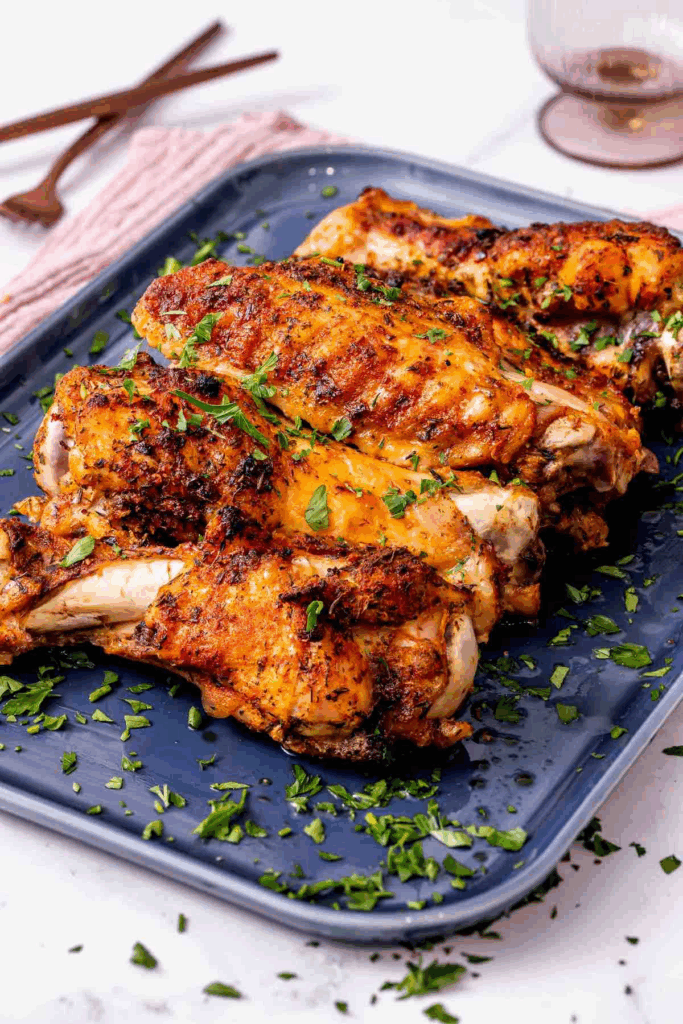
Common Mistakes When Cooking Turkey Wings
In my kitchen and over the years training home cooks, I’ve seen the same mistakes again and again. The most common is overcooking—people assume more time equals better tenderness, but dark meat dries out quickly once it passes 185°F. I always recommend using a thermometer, not guesswork.
Another issue is underseasoning. Turkey wings have thick skin and dense muscle, so light seasoning on the surface won’t cut it. I make sure to season under the skin or let dry rubs sit for an hour at minimum. Even better, I let them rest overnight in the fridge for deeper flavor.
I also often see people skipping the moisture component when roasting. Cooking turkey wings uncovered from start to finish can lead to tough meat and dry edges. I prefer starting covered, then finishing uncovered for browning. That gives me the best of both worlds.
Finally, not letting the wings rest before serving is a big misstep. Resting allows juices to redistribute. I’ve cut into wings right out of the oven before, and the difference when you wait 10 minutes is night and day. It’s simple but critical.
Chef-Recommended Sauces and Gravies for Turkey Wings
Good wings deserve a great sauce. When I want something rich and classic, I use a pan gravy made with the drippings, flour, and stock. I whisk it smooth, season it with salt, pepper, and a splash of wine or cream, and let it reduce to a velvety consistency. It clings to the meat without overpowering it.
For something lighter, I prepare a lemon herb butter using reduced broth, fresh lemon juice, chopped thyme, and cold butter whisked in at the end. This sauce is bright and perfect for roasted wings served with vegetables.
If I’m making spicy wings, I go for a hot honey glaze with chili flakes, garlic, and a dash of apple cider vinegar. I simmer it until thick, then brush it on during the last few minutes under the broiler. It caramelizes fast and adds a beautiful gloss.
Sometimes I serve wings with a cool yogurt-based sauce, especially when I’ve gone heavy on the seasoning. A simple mix of Greek yogurt, lemon zest, and dill balances the richness perfectly. I always match the sauce to the wing’s flavor style—it’s one of the simplest ways to elevate the meal.
Seasoning Blends That Work Best for Turkey Wings
One of my favorite parts of cooking turkey wings is experimenting with different spice blends. Their deep flavor and robust texture allow them to carry seasoning better than chicken, so I don’t hold back.
For something bold and smoky, I use a BBQ blend: smoked paprika, cumin, garlic, brown sugar, and chili powder. This works great on grilled or oven-roasted wings, and I finish it with a splash of apple juice or vinegar to cut the sweetness.
When I want heat, I make a Cajun mix with cayenne, oregano, garlic, thyme, and black pepper. I often coat the wings heavily and cook them in the skillet or pressure cooker, where the spices infuse the meat during the steam phase.
For a brighter profile, I love a lemon-pepper rub made with coarse black pepper, garlic, salt, lemon zest, and a touch of oil. I let the wings marinate for at least 30 minutes before oven roasting, then hit them with a squeeze of lemon juice right before serving.
I also experiment with Middle Eastern blends like za’atar or baharat, especially when I serve the wings with couscous or roasted eggplant. Turkey wings are incredibly forgiving—they take spice beautifully and reward creativity every time.
Popular Variations and Recipe Ideas
Turkey wings are far more versatile than most people think. When I want something cozy and classic, I slow-roast them with onions, carrots, and thyme, then finish with a brown gravy. It’s a one-pan meal that works every time.
On summer days, I smoke turkey wings over hickory or applewood. I season them with a dry rub, let them go low and slow for a few hours, then glaze with barbecue sauce. They come out tender with a deep smoke ring and crisp edges.
For an oven-friendly version of fried wings, I coat them lightly in cornstarch, spray with oil, and bake at high heat. It gives a crunchy finish without the mess of deep frying. A hot sauce butter glaze takes it to the next level.
When I want a rich, comforting dish, I stew the wings in tomato, garlic, and white wine, letting them simmer until they fall apart. I serve this with crusty bread or over rice—it’s one of my most-requested winter meals.
Turkey wings also work great in air fryers when separated into flats and drumettes. They cook fast, crisp up beautifully, and are easy to portion for snacks or game day spreads.
Storing and Reheating Turkey Wings the Right Way
Once cooked, turkey wings store very well. I let them cool fully, then wrap them tightly in foil or place them in airtight containers. In the fridge, they last up to 4 days. For longer storage, I freeze them for up to 2 months, always labeling with date and method used.
When it comes to reheating, I avoid high heat. For best results, I reheat wings in the oven at 300°F (150°C) for about 20 minutes, covered with foil and with a bit of broth or sauce in the pan to retain moisture. This keeps the meat soft and prevents drying.
If I’m using the microwave, I cover the wings with a damp paper towel and use medium power for even heating. I flip them halfway and check temperature after 2 minutes. It’s fast, but the skin won’t re-crisp.
When crispness matters, I reheat the wings in a skillet with a teaspoon of oil, skin side down, and warm them over low heat until the skin tightens and sizzles. This method brings them back to life and is my preferred way when serving leftovers to guests.
What to Serve with Turkey Wings and How to Plate Them
Turkey wings can be plated rustic or refined depending on how you prepare them. When I roast them whole, I often pair them with traditional comfort sides: mashed potatoes, roasted root vegetables, or green beans with garlic. These starchy, savory accompaniments soak up juices and sauces beautifully.
For braised or pressure-cooked wings, I like serving them over buttered rice, herbed couscous, or creamy polenta. The sauce from the cooking liquid becomes a built-in gravy that ties the plate together. I sometimes add sautéed kale or Swiss chard for color and a hint of bitterness to balance the richness of the meat.
When I shred the wings and serve them in tacos, flatbreads, or bowls, I go with quick pickled onions, yogurt sauces, and roasted peppers to brighten the dish. It’s casual and packed with flavor.
For plating, I let the wing shine. If the skin is crisp, I always plate it skin-side up. I spoon sauce either underneath or beside the meat—never over—so the skin doesn’t lose its texture. I garnish with fresh herbs or a thin drizzle of glaze, depending on the seasoning profile.
Whether it’s comfort food or something creative, turkey wings are incredibly adaptable. I always plate with intention—but never overcomplicate.
FAQ: 15 Questions About Cooking Turkey Wings — Answered by a Chef
Are turkey wings better cooked whole or separated into sections?
I recommend separating the flats and drumettes if you want even browning and faster cooking, especially in a skillet or air fryer. For roasting or braising, keeping them whole gives a more dramatic presentation and protects the meat with its own skin and bone.
How do I know when turkey wings are fully cooked?
I always use a meat thermometer and aim for 175°F (80°C) at the thickest part of the drumette. If you don’t have one, the juices should run clear, and the meat should pull easily from the bone. Trusting timing alone isn’t enough—I’ve made that mistake.
Can turkey wings be cooked from frozen?
Yes, but I recommend only in the oven or pressure cooker. Increase the cooking time by at least 50%. That said, I prefer thawing in the fridge overnight for even seasoning and texture control. I’ve had uneven results trying to season frozen wings.
Why are my turkey wings tough even after cooking?
They were likely cooked too hot, too fast, or not given enough resting time. Turkey wings contain connective tissue that needs gentle heat and time to break down. I suggest a lower oven temperature with foil cover or using a moist cooking method like braising.
Should I remove the skin before cooking?
I don’t. The skin locks in moisture and renders flavor into the meat and pan. If you prefer skinless meat, I’d cook the wings whole with the skin on, then remove it after cooking. That way you still benefit from its insulation.
What’s the best way to season turkey wings?
I always go heavy on seasoning. Dry rubs with salt, herbs, and spices are my base, and I let them sit for at least 30 minutes—ideally longer. For even deeper flavor, I use a citrus or vinegar marinade overnight. Don’t be shy with bold spices—wings can handle it.
Can I deep-fry turkey wings like chicken wings?
Yes, and I’ve done it many times. Just be careful—turkey wings are larger and contain more fat. I recommend parboiling or pre-roasting them until nearly done, then frying to crisp the skin. It prevents burning the outside before the inside is fully cooked.
Do turkey wings work in soups and stews?
They’re fantastic for slow-cooked dishes. I often simmer them in broth with vegetables, then shred the meat into the soup and save the bones for stock. They’re richer and more flavorful than chicken wings in this setting.
How do I make turkey wings crispy in the oven?
I start with dry skin, roast them on a rack at 375°F, and finish at 425°F uncovered. Basting with oil or pan drippings helps. The last 10 minutes are crucial—don’t crowd the pan, and give the wings space to breathe.
Are turkey wings healthier than chicken wings?
They’re similar in calories and fat per ounce, but turkey wings are larger and more filling. I find I eat less volume when I serve turkey wings. They also have more iron and slightly more protein per serving.
What’s the best way to reheat leftover turkey wings?
Oven at low heat with foil and a splash of broth is my favorite method. Microwave works too, but use medium power and cover with a damp paper towel. I avoid high heat—it dries the meat out and ruins the texture.
Can I grill turkey wings?
Yes, and they’re amazing over charcoal. I par-cook them in the oven or pressure cooker first, then finish them on the grill with a glaze. The skin crisps, and the smoke adds an incredible layer of flavor.
How do I store turkey wings after cooking?
I let them cool fully, wrap in foil, and store in an airtight container. In the fridge, they last about 4 days. In the freezer, they hold up well for 1–2 months. I always label with the date and type of seasoning used.
Can I use turkey wing tips for anything?
Absolutely. I save wing tips and freeze them for stock. They’re packed with collagen and make a rich base for soups, gravies, or sauces. Don’t throw them out—they’re liquid gold when simmered properly.
What’s your favorite turkey wing recipe of all time?
That’s easy. Roasted wings with smoked paprika, garlic, lemon zest, and rosemary, basted in their own fat, then served with a mustard-herb sauce and crusty bread. I’ve made it for dinner parties and weeknight meals alike—it never fails.



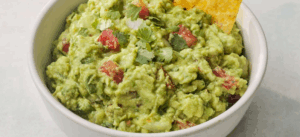
Post Comment